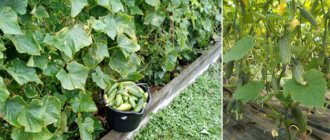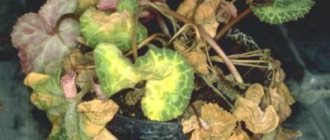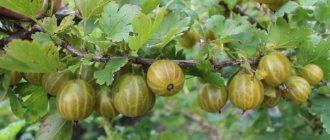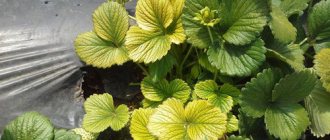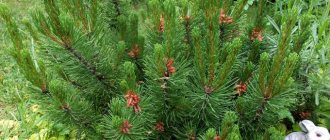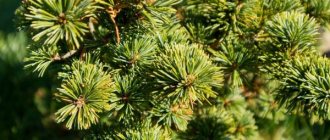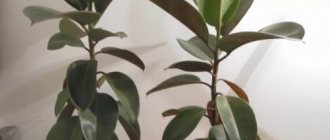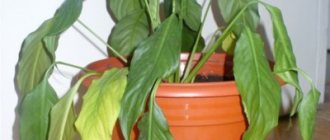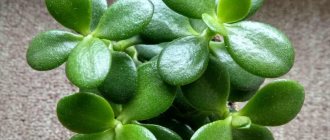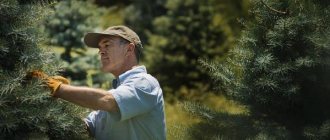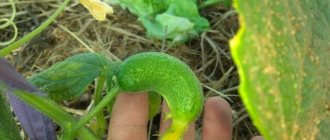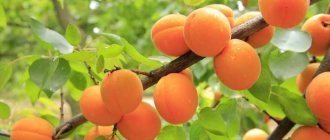Bushes and trees
0
522
Article rating
Kira Stoletova
When growing coniferous trees, gardeners are often faced with problems of loss of decorative value when the needles burn out, fall off and die as a result. Why does pine turn yellow and how to fix this problem?
Yellowing of pine needles: causes and treatment
Autumn color changes are normal.
Like any plant, pine needs foliage renewal. The lifespan of needles is only 4-5 years, after which they begin to fall off. This process occurs almost imperceptibly, since mainly those branches that are located as close as possible to the trunk are exposed.
If a pine tree changes color in the fall, it means that the process of needle renewal has entered its final phase. This is completely normal, so no action needs to be taken. The only exception is that it is necessary to periodically cut off dried branches so that they do not interfere with the development of the plant.
As mentioned above, during renewal, only those branches that are in close proximity to the trunk turn yellow. At the same time, young shoots and ends of branches must remain green. Otherwise, the affected parts of the plant will also need to be pruned to prevent the spread of the disease.
Treatment methods
Having noticed that the pine needles are turning yellow, you should establish the cause of what is happening. If no obvious problems are noticeable, you should analyze the planting procedure, growing location, watering and fertilizing. The breed prefers areas exposed to sunlight with sufficient air and soil moisture. At the same time, it does not tolerate waterlogging; in an unfavorable microclimate, immunity decreases, and the plant becomes infected with fungal infections.
The buried root collar must be freed from soil and pine needles. It is advisable to replant the young seedling if the location chosen is unsuitable. Watering should be done early in the morning, moderately, with settled water; for adult plants, the autumn moisture recharging procedure is often sufficient. During drought, it is recommended to sprinkle the crown. The evaporation of the liquid will delay the mulching of the tree trunk circle. When a dense earthen crust forms around the pine tree, it must be loosened.
The breed prefers areas exposed to sunlight with sufficient air and soil moisture.
For the first 2-3 years, fertilizing is often not required, with the exception of if the soil has not been previously prepared. Excess fertilizer can cause more harm than deficiency. At the same time, if you notice signs of a lack of any nutrient, you should water the tree with the appropriate fertilizer for conifers. Before or after the procedure, it is necessary to moisten the tree trunk well so that aggressive components do not burn the pine root system.
In case of fungal infections, it is recommended to reduce watering and, if possible, provide the plant with access to fresh air and sunlight. The affected branches must be removed, burned, and the rest of the tree must be treated with chemicals or biological products approved for use on pine. When infected with incurable diseases, it is recommended to cut down and destroy the tree to avoid damage to neighboring plants.
When the needles turn yellow due to the appearance of bark beetles or pine beetles, you will have to seek the help of a forestry specialist. Conventional insecticides are often useless, and effective products are prohibited from public sale. For other insects, you can choose an effective preparation for treatment in a specialized store. In advanced cases, you will have to cut down the affected branches.
The affected branches must be removed, and the rest of the tree must be treated with chemical or biological preparations.
Massive yellowing of needles: what is the cause of the problem
If a pine tree in a summer cottage turns yellow not only at the trunk, but over time it acquires an unpleasant red or dark orange tint, then most likely this is due to an attack by pests. It is necessary to get rid of them urgently so as not to lose the entire tree.
Pine also changes its color for a number of other reasons.
I am often asked why the needles of pine and other coniferous plants in the garden turn yellow in early spring and mid-summer. There may be several reasons. Of course, it is worth considering each case separately. But there are also general recommendations that will help in case of minor ailments of conifers. And if, after trying these methods, there is no result, you will have to use more complex treatment regimens and, preferably, after consultation with a specialist.
Why do the needles of pine and coniferous plants turn yellow?
Here are the most common causes of the disease:
- In summer, this is most often a lack of moisture or diseases and pests.
- And in the spring there may be costs of late planting or sunburn.
Algorithm for treating coniferous trees in case of yellowing of needles
- Use pruning shears to cut out any branches that are severely damaged, but before doing this, make sure that the branches are completely dry. Some conifers, for example?? thujas may sprout new shoots on yellowed branches.
- Wear gloves and try to remove yellowed needles from the middle of the tree.
- Treat the crown (spraying through a sprayer) with all the specimens that you think need help with the drug “NV-101”.
- Spray the root system of the tree with the same preparation “NV-101”.
- After 7 days, water the root system with Kornevin at the rate of 1 gram per 1 liter of water.
- If necessary, repeat treatment of coniferous trees at intervals of 1-2 weeks until the plant is completely restored.
More and more owners of suburban areas are planting coniferous trees on them, incl. pine trees. Believing that plants should remain green all year round, owners of pine alleys become desperate when the needles lose color. They are interested in why pine trees turn yellow and what can be done to save the tree.
Pines are evergreens, so gardeners believe that autumn yellowing and falling of needles cannot occur for natural reasons, but this opinion is wrong. The green cover of a tree does not last forever and must be renewed regularly. The frequency of the process is from 3 to 5 years, but this does not mean that the needles will turn yellow and fall off once every 3 years. Dry needles will appear annually a few years after planting.
First of all, the needles on the lower branches near the trunk turn yellow. Over time, the dried needles fall off. Some discolored foliage should not be a cause for concern. Natural yellowing can affect up to 40-50% of pine needles, but it should not extend to young tree shoots and branch ends.
Signs of the normal course of the process are yellowness, evenly spread over the lower part of the pine, and annual renewal of foliage. A summer resident who has learned why pine needles turn yellow in the fall can only trim the branches freed from the cover as close to the trunk as possible. This contributes to more active development of the tree.
Pests
Yellow needles from pests
If the pine tree has turned yellow, the reason may be due to infestation by harmful insects. This conifer has several dangerous enemies.
Spider mite
The small insect weaves a thin web around the nodes, buds, young shoots and needles. The pest loves to feast on the juice of young organs; the affected tissues begin to turn yellow and die.
In the fight and for prevention, acaricides are used - Actellik or Aktaru. Before spraying, remove damaged parts.
Aphid
This sucking insect settles in colonies and in a short period of time can destroy all the needles.
Affected buds, needles, and young branches turn yellow, dry out and fall off.
- At the early stage of infection, folk remedies will help you cope with the pest: ash and soap solution, infusion of tobacco, garlic or hot pepper.
- At an advanced stage, it is necessary to use pesticides - Fundazol, Skor or Actellik.
Bark beetles
These parasites on pine trees can be identified by numerous holes on the central conductor and skeletal branches.
An exhausted plant begins to turn yellow, dry out, and eventually die. To combat it, you need to regularly dig up the area in the fall to destroy the larvae overwintering in the soil.
Additionally, hunting belts made of sticky materials are installed on the trunks.
Hermes
The larvae infect the needles en masse, covering them with a white coating; later the needles turn yellow, dry out and fall off en masse. To combat these parasites, chemical agents are used - Calypso, Confidor Maxi or Mospilan.
Red pine gall midge
A small dipterous insect can lay more than 100 eggs in one clutch, from which sucking larvae hatch. They chew out the needles, which leads to their yellowing and drying out.
To combat, several effective drugs are used - Enzhio, Aktaru, Mospilan or Calypso.
Mealybug
These pests damage, first of all, the root system, and later move to the above-ground part.
Infected needles curl and become yellowish. With severe damage, the shoots seem to be covered with frost.
Folk remedies will help get rid of insects at an early stage of infection - spraying with a solution of green soap three times with an interval of 7 days (10-15 g of substance per 1 liter of water). You can also spray the crown with infusion of tobacco, garlic or cyclamen decoction.
At an advanced stage, only chemical preparations will cope - Tanrek, Confidant, Aktara, Mospilan, Calypso or Confidor. Spray twice every 10 days.
Shchitovka
It is easy to identify pests - small reddish plaques stick to young shoots and needles, suck out the juices from them and lead to yellowing and drying out.
The effective drug Decis will help get rid of the parasite. Irrigation of the crown is carried out twice with an interval of 5 days. Adults can be collected by hand.
Why does pine turn yellow in summer?
Summer yellowing of pine needles is associated with climatic conditions that are unsuitable for the normal functioning of the plant. In summer, when hot, dry days predominate, pine suffers from lack of moisture and sunburn. Trees that have been recently planted do not tolerate heat well. Their branches do not yet receive nutrients from the roots, and the loss of moisture, not compensated by the supply of water from the soil, leads to the drying out of the needles. Mature trees can withstand dry periods relatively well.
Oversaturation of soil moisture near the root system leads to plant disease and yellowing of the needles. They prefer sandy loam and sandy soils with good drainage, and the heavy clay soils of the southern regions do little to promote the development of trees. The condition of plants is negatively affected by a lack of nutrients: the soil under the tree quickly becomes poor, so it needs regular fertilizing. The yellowness of pine needles signals a lack of phosphorus and iron.
Preventive measures
It is easier to prevent any problem than to eliminate it, so simple preventive measures will help you grow a strong and beautiful tree.
To do this, it is necessary to follow agrotechnical techniques, planting and care rules.
- Plant in a sunny place with slight shade, where there are no swamps and strong winds. When planting, it is important to avoid crowding and use high-quality and healthy seedlings.
- Adjust the watering regime to prevent drying out or waterlogging of the root system, and as a result, yellowing of the crown.
- Adhere to the frequency, scheme and dosage of fertilizer application - the first feeding is carried out in the second year after planting and only twice in the spring with nitrogen, and in the fall with phosphorus-potassium. Additionally, the crown is irrigated with chelated products three times during the summer.
- Provide good access to light so that the needles develop fully and have a rich green color.
- Before wintering, insulate it to protect against freezing in winter and damping out in the spring.
- Regularly inspect for disease and pest damage and provide appropriate treatment if necessary. For preventive purposes, disinfection treatments are carried out with fungicides and insecticides.
Why do the needles turn red?
If the foliage has acquired a rust color, this indicates a tree disease caused by a fungal infection. A group of pathologies of this type is united under the general name - Schütte. Young plants are more affected by the disease, but shutte can also be dangerous for mature trees. A sign of the disease is the rapid reddening and death of needles after the snow melts. This may happen within 1 week.
Black lines and spots appear on needles affected by common schute. Mature trees react to pathology a month after the snow melts by reddening and dying of the lower part of the needles. If you examine the needles that have fallen from a diseased pine tree at the end of summer, you will see black lumpy spots and transverse streaks on them.
The causative agent of snow shutte is activated in winter. Symptoms of plant disease can be seen when the snow settles. Pine branches with orange needles are covered as if with frost. The grayish coating is easily destroyed, but browned, fungus-damaged needles acquire the same shade and fragility by autumn.
A pine tree affected by brown schutte does not shed its diseased needles for a long time. A coating on browning foliage entangled with fungus becomes visible immediately after the snow cover melts.
Unnatural browning of foliage can be caused by the activity of the pine beetle. There are the following signs of damage:
- streaks of resin on the trunk and branches;
- powdery sawdust of a brownish or light shade that appears on the wood or under the trunk (drill flour).
Main reasons
In order not to get confused and correctly answer the question - why does pine turn yellow, I will divide the reasons into three groups:
- Natural vegetative processes or varietal characteristics.
- Poor choice of planting site, improper care.
- Diseases, infections, pests.
Let's look at it in order.
Why do pine trees turn yellow in autumn (natural processes)
Any gardener who is interested in growing conifers should know that every 3-5 years the pine tree changes its needles. Old needles turn yellow, dry out and fall off. They are replaced by young ones. This usually happens in the autumn. There is no need to be afraid of this phenomenon. This is the norm for evergreen conifers.
The adaptation period after planting a seedling may also be accompanied by yellowing of the needles. As a rule, within 1-2 months the seedling takes root well and the natural, green color of the needles returns on its own.
In addition, there are pine trees, the needles of which, due to varietal characteristics, change color in the winter from emerald green to various shades of yellow, up to bright lemon shades (for example, varieties Gold Coin or Carstens Wintergold).
The warm, amber color of Winter Gold weedy pine needles against the backdrop of dazzling white snow is a delightful sight. Photo: ogrodeus.pl
What to do if the needles turn yellow?
The cause of yellowing of pine needles can be not only inadequate care of the plant, but also inappropriate procedures. Excessive use of chemicals on wood can cause chemical burns to wood tissue. You should not fertilize the soil under the pine tree in the fall. The best time to use fertilizers is spring. Phosphorus fertilizers are applied during the growing season every 2-3 weeks. Compost and biofertilizers are useful for pine, but their excess in the soil is harmful to the tree.
Summer residents often make mistakes when planting a plant, choosing the wrong place for the seedling, incorrectly immersing it in the soil, or choosing the wrong soil. It is better not to plant pine in lowlands where water drainage is difficult. Frequent arrangement of seedlings is unacceptable, because the tree loves light. Pine trees are planted no closer than 3 m from each other.
When growing pine in areas with heavy soil, you need to ensure good drainage. Sand should be added to clay soil because... pine loves loose soil. Planting a seedling shallowly in unenriched soil and immersing the root collar in the ground will lead to yellowing of the needles. The tree does not need to be planted near roads. Car exhaust inhibits plant growth.
Periodic treatment of the tree with fungicides and spring spraying with Bordeaux mixture will help prevent the development of fungus. Other copper-containing preparations can be used to treat wood. It is useful to scatter wood ash or crushed peat under the pine tree to combat fungal diseases. This can also be done to accelerate the melting of snow cover, which is an optimal environment for the life of certain types of fungus.
If you suspect a tree disease, you need to call a tree pathologist. He will accurately determine the cause of yellowing of the needles and use the most effective drugs to eliminate this phenomenon.
In autumn, you can often observe how the needles on old shoots of pine trees turn yellow, while young shoots remain green. Why do the needles on pine trees turn yellow? This question worries many gardeners. If the pine trees turned yellow in the fall and if the howl turned yellow only on old 3-4 year old pine shoots, then this is a normal biological process. Such yellowing should not frighten owners of country estates who have planted pine trees on their plots. But what's the matter if the needles take on an unnatural bright orange, red or red hue? What if the needles on the pine trees turn yellow by more than half of the total mass of needles. First of all, you should check whether the pine tree is attacked by stem pests. Pests are the main cause of severe yellowing, redness or redness of needles. It is the stem pests - bark beetles and pine beetles - that give that bright and unnatural shade that the needles of the affected tree acquire. The photo shows pine trees infested with stem pests. The color of the needles is an unnatural bright red; the pines have turned yellow by more than 50% of the total mass of the crown. In addition to the yellowing of pine trees, a diagnostic sign of a pest attack is smudges of resin on the bark of pine trees and drill flour on the trunk, which is left by bark beetles. Boring flour can be found on the trunk of a pine tree near the holes left by pests in the burrows and in the lower part of the tree. As a rule, the presence of drill flour indicates the death of the tree. If you find it difficult to make a diagnosis, invite a forest pathologist to your site, who will diagnose why the pine trees on your site have turned yellow and, if harmful factors are detected, will give recommendations for treating the trees. Another sign of a pine tree being infested with stem pests is young shoots lying on the ground under the pine tree. If a neat hole is visible in such shoots (photo), then this indicates an attack by a large pine beetle. The pine beetle greatly weakens the pine tree by eating away the core of young shoots. The beetles then colonize the trunk. The fight against bark beetles and pine beetles involves their timely detection and destruction. Remember that stem pests are one of the most dangerous types of tree pests and are extremely difficult to eradicate. Self-medication here will do more harm than good. Many gardeners, when they detect stem pests, begin to actively water the pines with publicly available insecticides (for example, Fufanon or Kinmiks). On the one hand, this does not get rid of pests that continue their destructive activities under the bark, and on the other hand, it harms the ecological balance in the area. In the professional fight against bark beetles, special preparations are used that are not available for free sale.
So, if your pine trees turned yellow in the fall, remember how the needles turned yellow on them last fall? And the day before last? What about 3-4 years ago? If so, don't worry, the trees are fine. This is a natural process - the pine tree simply changes its needles. If you have doubts about differences in color and the amount of dried needles, or if you suspect that the trees are infested with pests, use the services of a forest pathologist. The visit of a specialist is inexpensive, and you will calm down if everything is in order with the pine trees and begin treatment on time if a damaging factor is identified. In addition, the forest pathologist will give recommendations on the proper care of pine trees.
Did you know that even evergreens are not evergreens? We choose them because they retain their attractive appearance for a long time. But surprises happen: conifer needles begin to turn yellow. What is the reason? Let's look at why pine needles turn yellow.
Incorrect landing
An important step in successfully growing pine trees is their proper planting.
Often, novice gardeners deepen seedlings into the soil along with the root collar. After some time, it begins to rot, and the needles on the crown turn yellow and crumble.
You need to follow one simple rule - plant the plant so that the trunk neck remains 5-6 cm higher than the soil surface.
The second point that provokes this phenomenon is landing in a wetland. Ephedra does not like stagnant moisture.
There is a high probability of yellowing of pine trees growing in the open sun. The scorching rays burn out the tender and juicy needles, as a result they look burnt, dry out and fall off.
Choose a shaded location with good access to daylight.
You can plant pine next to tall trees with a wide spreading crown.
Densified plantings are another reason why pine trees in a garden plot turn yellow. In crowded conditions, plants begin to compete for space, moisture and nutrients; the weakest ones change color, dry out and crumble.
Depending on the variety, it is worth maintaining a certain distance between seedlings, taking into account the dimensions of an adult tree.
Pine turned yellow: causes and treatment, prevention
27.09.2018
- 1 Why does pine turn yellow?
- 2 Treatment methods
- 3 Prevention
Coniferous perennials are one of the best decorations for any garden plot.
The needles remain green all year round, with the exception of cases when the color changes for a while according to the varietal characteristics. If after winter the pine tree turns yellow, it is necessary to establish the exact cause of what happened.
A change in color does not always indicate serious problems, but this possibility cannot be ruled out.
What to do if a young pine tree dies?
The top of the tree turns yellow, and it actively sheds its crown. How to find out the cause and remove yellowness? First of all, you need to analyze the place where your pine tree grows and remember the planting procedure. Maybe the reason lies in improper care, watering, or the plant does not have enough nutrition. The pine tree requires high air humidity and constant exposure to the sun. However, it does not tolerate waterlogging and can become infected with one of the types of fungal infections.
Check the root collar first. If it is closed, then free it from soil and fallen needles. When a dense earthen crust forms, loosen the soil around the trunk. It is necessary to water the pine tree early in the morning with settled water. If there is a drought in the yard in the summer, then spray the plant. The location you choose may not be suitable for a young pine tree. Understanding this, it is better to transplant it into another, more suitable one.
It is advisable not to fertilize for the first three years (excess fertilizer will affect health). An exception may be the case when you planted a tree not according to the rules. As soon as you notice a lack of nutrients, you should feed the plant with fertilizer for conifers.
To prevent the chemical composition of the fertilizer from harming the trunk, water the tree trunk circle more often during the week.
The symptoms of Schutte can be defined as follows: the needles fall off when touched, red and brown needles appear, and brown spots appear on the trunk. If such symptoms are detected, it is necessary to remove fallen needles from the trunk - they contribute to the proliferation of the fungus - and treat the tree with a special composition (Benomil, colloidal sulfur, Bayleton). And for prevention, twice a year - in autumn and spring - sprinkle peat or ash around the tree .
A more difficult case is if rust appears. At the same time, the bark of the plant cracks, and orange-yellow bubbles appear from the cracks. This is a chronic disease that leads to death. But if you treat the plant in time, you can save or revive it. To do this, clean the wound and treat it with copper sulfate (5%), then apply a protective composition on top.
A plaque has formed on the pine tree. What is this? Your plant has been attacked by hermes, which suck all the juices out of the plant. To avoid death and further reproduction of parasites, treat the tree with Karbofos three times. The break between procedures should be two weeks. Bark beetles and pine beetles are parasites that are very difficult to destroy. Often the drugs sold in stores do not work on them. If a plant is dear to you, then seek help from forestry specialists.
You can revive a pine tree like this: cut off the affected branches and burn them. In other cases, regular insecticides will help.
In order to avoid problems, it is better to engage in prevention. It should begin with the planting itself. Choose the right place for your seedling in the garden. Create the right microclimate. A number of the following measures will also help in this matter.
- In autumn, it is necessary to saturate the plant with moisture, and during the warm season, follow the watering regime.
- Compliance with feeding rules. It should begin three years after planting the plant.
- The planting must have a solar light source that meets all its requirements.
- It is necessary to protect the tree from the cold in time. To do this, cover it with special material for the winter.
- Prevent diseases and kill parasites using fungicides and insecticides.
To learn why pine needles turn yellow and how to deal with it, watch the following video.
Diseases
Necrotization of pine needles can also be caused by diseases of coniferous plants, which affect both mountain and ornamental varieties of the crop. Among the most common are rust and brown schutte.
Rust
A fungal disease, a favorable environment for the development of which is hot weather and dense plantings.
Important! A tree suffering from fungal diseases should not be watered. The procedure for spraying with insecticides should be carried out in cloudy weather so as not to burn the plant.
Symptoms of the disease include the appearance of bulges and growths on trunks and skeletal branches that have a characteristic orange or red color . The development of the disease leads to the loss of color in the needles, then the plant sheds both needles and young shoots.
Treatment is carried out by sanitary pruning of diseased parts of the plant and treatment with “Ridomil”, “Gold”, “Tilt” or “Skorom”
Brown Schutte
If the tips of the pine needles are covered with yellowness, this may indicate that the tree has become infected with the fungal disease brown chute. Yellowing quickly spreads throughout the needles, then the needles take on a reddish color, and coniferous leaf fall begins . The peak development of the disease is the beginning of summer. At the end of summer, the progressive disease signals itself with black dots on young shoots and needles, which are fungal spores.
Did you know? If your children are capricious, then you should put a bouquet of pine branches in the room. The scent of this pine tree has a calming effect.
This disease is fraught with rapid death of the pine tree . At the first signs of its appearance, it is worth taking radical measures: cut off all diseased areas of the plant, treat the crop with copper sulfate solution, Bordeaux mixture or the chemical preparation Ridomil Gold.
To prevent the disease from appearing, adjust watering, since the fungus appears due to lack or excess moisture, and also monitor whether the tree receives enough sunlight, which is necessary for photosynthesis
Anyone who believes that pine is a tree that you just plant and forget about is deeply mistaken. Culture does not grow on its own. She needs to be well cared for and protected from pests and diseases. The slightest changes in the appearance of the pine tree should alert the gardener, as they may be a sign of serious problems. First of all, a tree signals that something is wrong with its vital activity by the color of its needles. If its yellowing is not seasonal, then it is worth looking for the cause and eliminating it.
